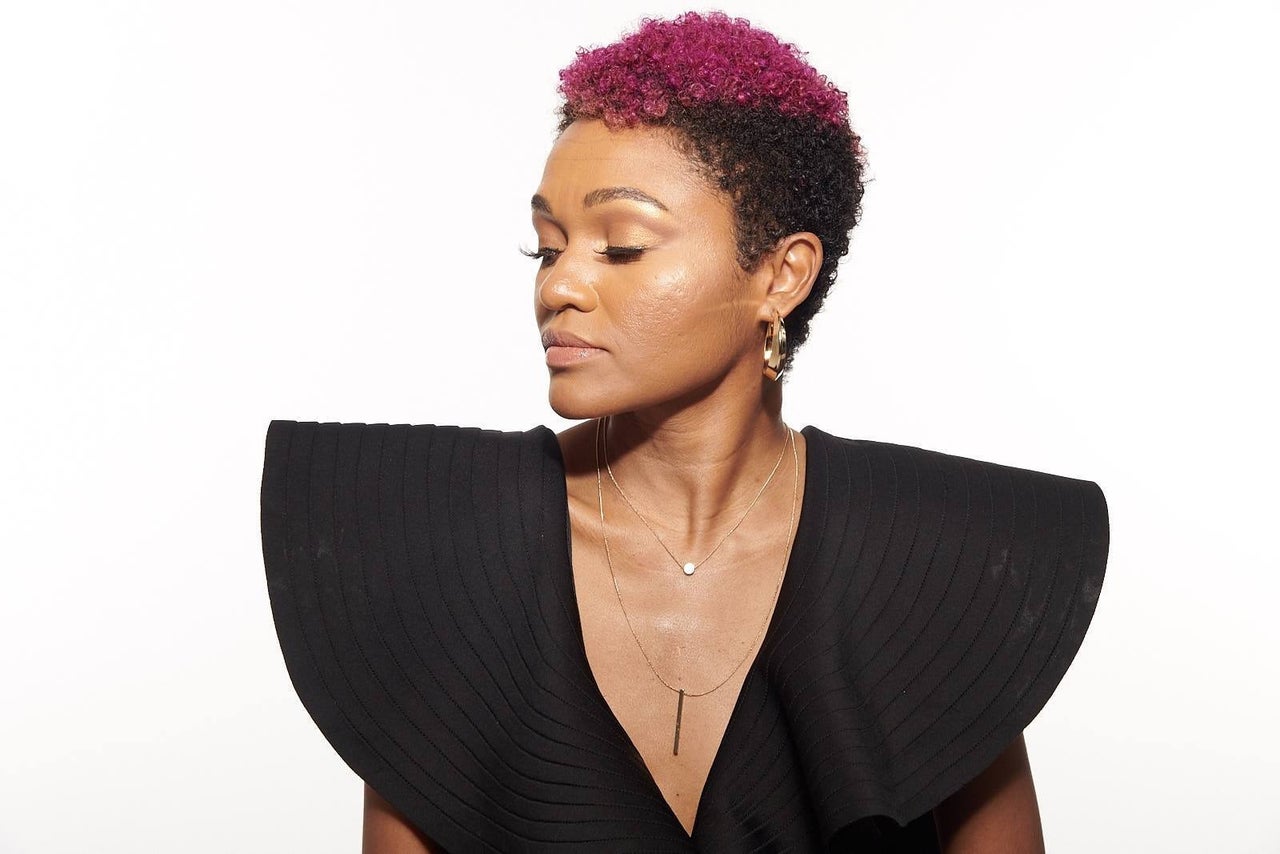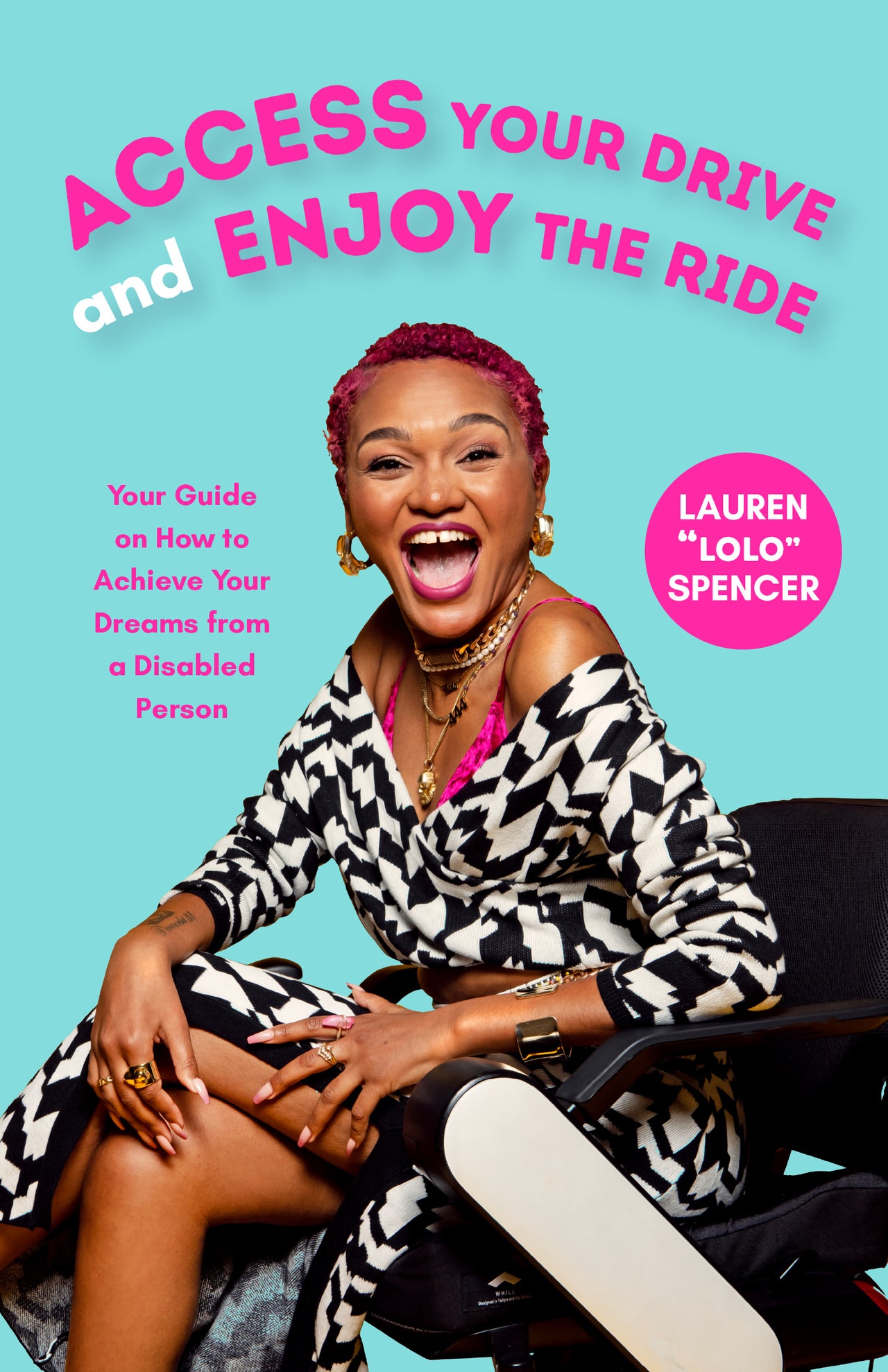Lauren ‘Lolo’ Spencer’s Book Is A Master Class In Finding Joy As A Young Disabled Person
Positivity is a choice that Lauren ‘Lolo’ Spencer had to consciously make at 14 years old, when she stared down a daunting diagnosis of ALS ― one that predicted that she had five years left to live. She said, “Nah, not me,” and never looked back. Now at 35, she’s a model, actress, disability advocate who dropped a memoir this week called, ” Access Your Drive and Enjoy The Ride: A Guide on Achieving Your Dreams from a Person with a Disability.” In it, she describes the important decisions she’s made after her body began to change, including the one to live a robust happy life from the comfort of her power wheelchair.
Contrary to popular belief, happy, young wheelchair users do exist. After all, a mobility aid doesn’t limit us, as so much of the world believes. It, in fact, provides us with the agency to live freely and as independently as we can.
No one debunks the outdated, sad-disabled-person trope quite like Spencer. Her entire career, stemming from her YouTube channel, Sitting Pretty, has been dedicated to showing people “all the positive, fun, dope things” she does in life to show that disability lifestyle can be “fun, fly, and sexy, just like anything else.” Spencer not only wants to educate non-disabled people about disability — especially the experiences of a wheelchair user — but also empower other disabled people to live complete lives.
As a young, female wheelchair user myself, Spencer’s energizing attitude towards every challenge in life has been an antidote to the negativity that often creeps up for me. Of course, it’s natural for anyone to feel sad sometimes but I always believed that because of my disability, my happiness would come with giant caveats. But to that oppressive belief, I’ve learned to say, “Nah, not me.”
Though Spencer’s been dealt a tough hand, she’s remained committed to living authentically on her own terms, which is a journey I am also on. And while I’m still finding my footing on this path, Spencer gave me an enlightening peek into how she’s crafted her beautiful, bountiful life.
In your book, you say non-disabled people don’t understand how a disabled person can live a happy life — this really resonated with me. And you are a life-affirming rebuttal to that. Where does your positivity come from?
Ultimately, I would say it really comes from my family and friends. You know, I always give them as much credit as I possibly can because I’m a firm believer in the importance of your environment and having people around you with like-minded beliefs and morals. I have been incredibly blessed to be part of a family that’s always remained positive and one that knows how to have a good time. I come from a family full of musicians and so, to party, to listen to music — all of that has been in my DNA all of my life.
When I was diagnosed, nobody changed, and that was really imperative. Because I was born into that energy with my family and then it grew with all of the friends that I’ve made over time that have similar perspectives on positivity. I really attribute it to them and, of course, doing my own work through therapy and ultimately, making a choice. That’s kind of like the theme of the whole book is being able to make a decision [to be happy]. I know the other option is to just wallow in my own sorrow so I do my best to always fight to stay on the other side.

Where did your courage to be independent come from, especially in a world where everyone expects you to be dependent?
I get a lot of my courage from my mom. My mom is a firecracker in her own right. She’s a little 5-foot woman, but she is no joke. When she has her eyes and heart set on something, she is going to figure it out. Also, my mom never allows anybody to take advantage of or mistreat her. She’s had the courage to walk away from some tough things in her life and being there to witness what that looked like, all the sacrifices that she’s made, l would say a lot of my courage definitely comes from her.
I’ve also never seen her complain or get upset about her circumstances being a single mother. She just really did her thing. She was always just so organized, and it just always felt like she had her stuff together, so mature, responsible. I was like, “Damn, I want to be like that!” She has ingrained a lot of my courage inside of me. A huge part of writing this book was the exploration of the root of who I am really showing up.
When you were diagnosed with ALS, the internet told you your life expectancy was just five years. Was proving that prognosis wrong a big source of motivation for you?
Absolutely. I was so young. It was 2000 or 2001 — around that time, ideas of therapy, manifestation, law of attraction…all of that was not popular back then. But when I was writing the book, I recognized that I was practicing [positivity] that whole time, even back then.
So when I saw the [description of ALS] from the AOL search, it really naturally kicked in to be like, “No! This can’t be right.” It was not denial because denial more so sometimes feels like we’re trying to act like the truth isn’t the truth… I was more like, “What is this? No-no-no-no-no-no-no.” I couldn’t even read any more of the article because it felt like such a repellent against my natural spirit, my vibe, my energy and who I was at the time. I was like, “This is negative, I don’t like this. I don’t want this. This isn’t me.” And I literally just kind of took that as my motivation moving forward.
Your experience of getting a power wheelchair was very different from my own — I just cried incessantly for days — how were you able to approach such an emotional situation with maturity? How were you able to ignore your ego?
At first it was a little scary because I’m like, “What does this mean? What does this look like? How long am I going to be in this thing? This is weird. None of my other friends have this. This isn’t cool. This doesn’t look cool.”
But, when I sat in that chair and I played with the joystick to drive it, I said, “Oh yes, this is it. This is it.” Because for me, it was exhausting wearing my AFOs (ankle foot orthoses). My feet hurt by the end of the day. The straps were digging into my skin. I couldn’t switch my shoes because only one pair of shoes could fit the AFOs, so when I sat in that wheelchair, I was like, “Wait! I’m not tired. I can move around as much as possible. This is legit.” So then when my friends finally saw me use it, they jumped for joy and were super excited. That just confirmed to me that this was actually a good thing to use one of these wheelchairs.
So then when I moved to LA, using the chair more predominantly and seeing how far I could go with it, I was like, “Oh! I’m about to go to the mall,” “I’m about to go to this restaurant I’ve been dying to eat at. Let’s go!” I was ready to go everywhere.

What do you want people to take away from this book about young disabled people — and wheelchair users specifically?
I would love for people to realize that people with disabilities have options and possibilities. We don’t live that one, linear, depressed, “needing a superhero to come save us” trope that has followed the community forever. There’s this myth that we are completely incapable of living and that life isn’t good for us because we may use devices or our bodies work differently.
I want people to see the humanity in my story. Any person with a disability has a story and it’s bigger than the “What happened to you” question or “Why are you in a wheelchair?” Our lives are so much bigger than those moments, and I want that to be really ingested by anybody who reads the book — disabled or not — to know that we are bigger than our disability. It’s about our humanity, our lives, and our experiences first.
About wheelchair users, I want people to understand that the device is there to make our quality of life better. It’s not to be shunned upon, to ignore, to dismiss but just look at it the same way you would a car. Just get me from point A to point B. As long as the cushion is good and comfortable and I can sit in it for a good time, that’s all that matters.
People in wheelchairs are constantly dehumanized and desexualized, but you, and your character Jocelyn on “The Sex Lives of College Girls,” have shut that down. Also, in an episode of Sitting Pretty, you wondered if men don’t see you in “that way” because of your wheelchair. I identified with that so much. How do you cope with that insecurity?
That is actually an insecurity I still struggle with: men seeing beyond my disability and seeing me as an equal romantic partner in a relationship. The thing I’ve learned over time continuing to date — especially at my big age — men perceive their role in a relationship with a woman with a disability completely differently than they would if partnered with someone who is non-disabled.
Being able to get further insight on their perspective has been eye-opening. The more I continue to date, I take it less personally if they don’t see me in “that way” because it ultimately boils down to a complete lack of understanding and social conditioning. If someone hasn’t had a disabled person or specifically a wheelchair user close to them in their lifetime, they just simply don’t know. They don’t know. So their imaginations run and it’s kind of our responsibility to a degree to bring them to the reality of what it actually really takes to be in relationships with us.
That’s been one of the biggest lessons I’m learning from dating right now: learning how not to take those conversations about my disability personally or as if it’s an attack. I try to offer them more clarity and understanding … Men, unless they are in that space where they are in a mature space to build a long term relationship, they don’t want to risk hurting our feelings — because hurting our feelings seems to be way worse than hurting a non-disabled girl’s feelings for whatever reason.
But it’s still tough. It’s still very, very tough. It is an everyday thing to fight through and let my confidence shine. When they do learn who I am, they love me. Oh girl, th
Credit: Source link